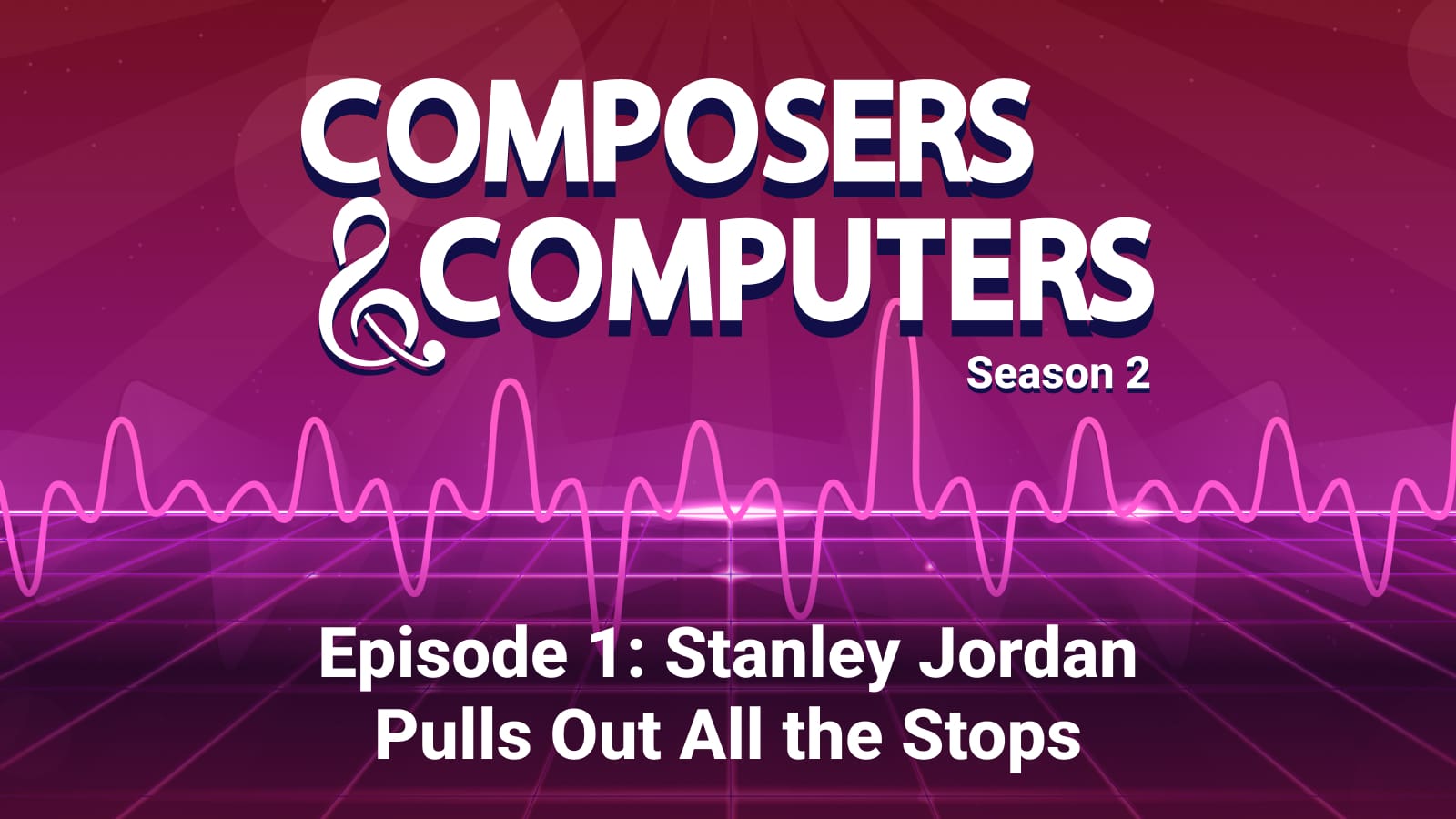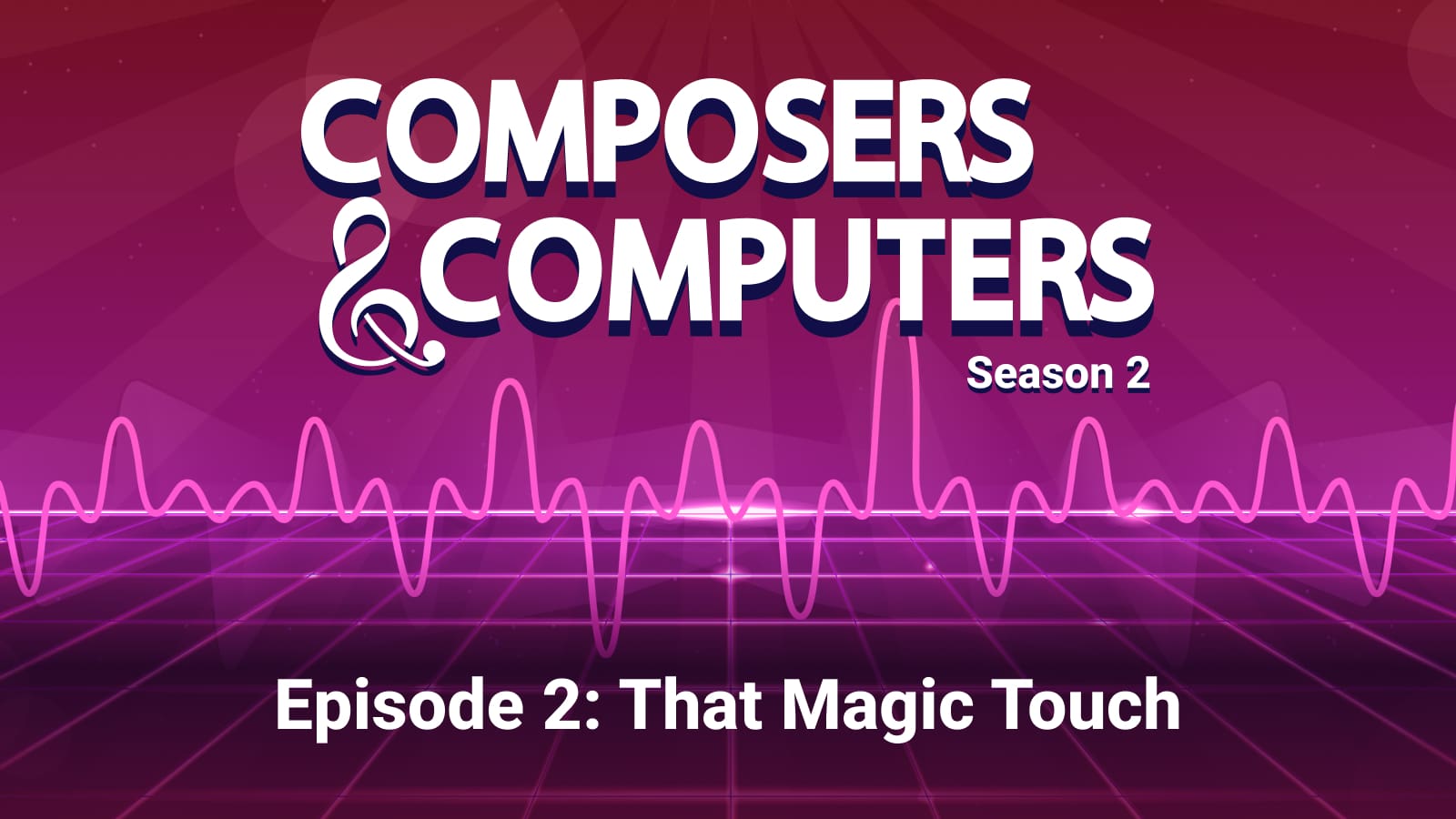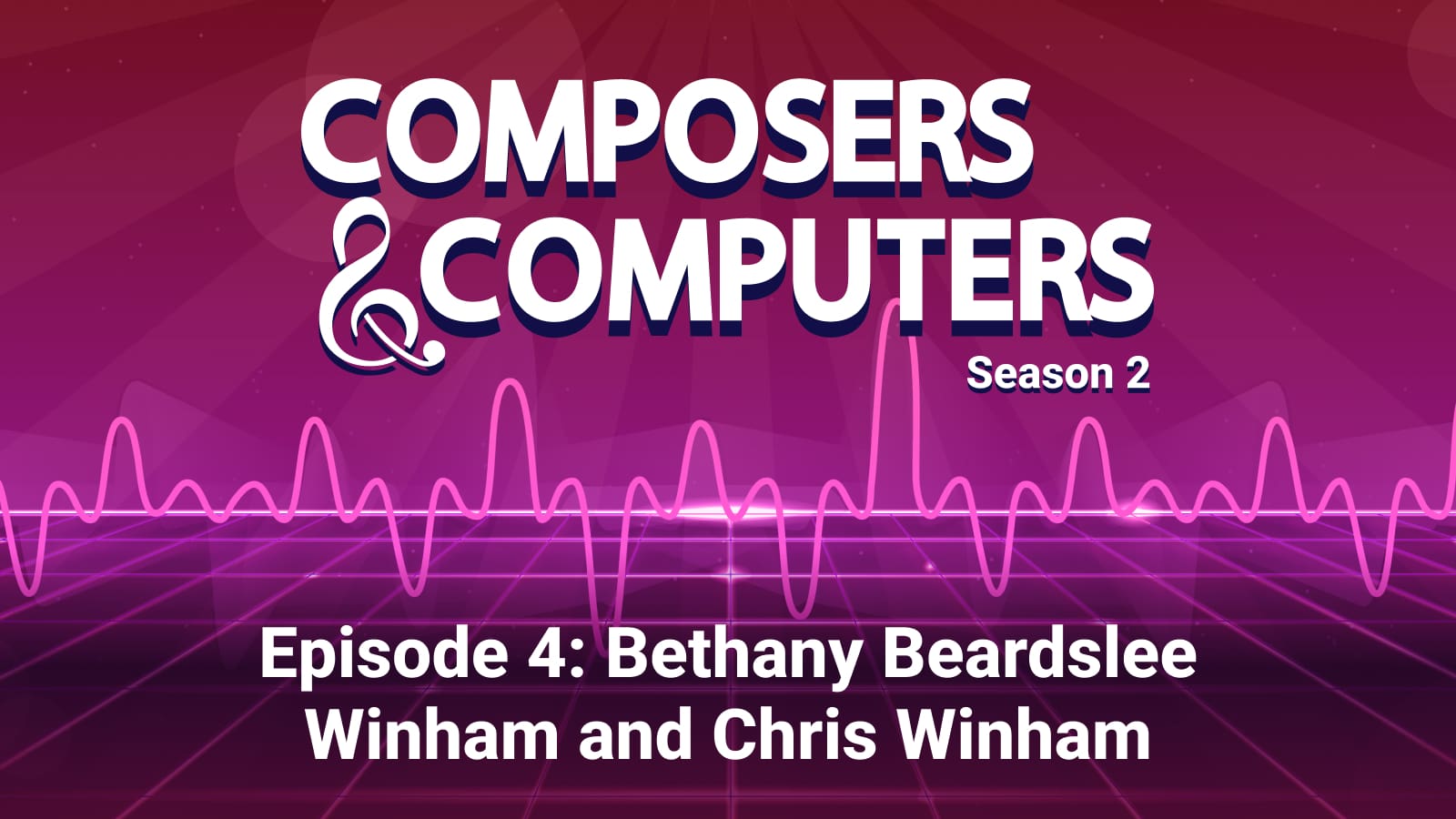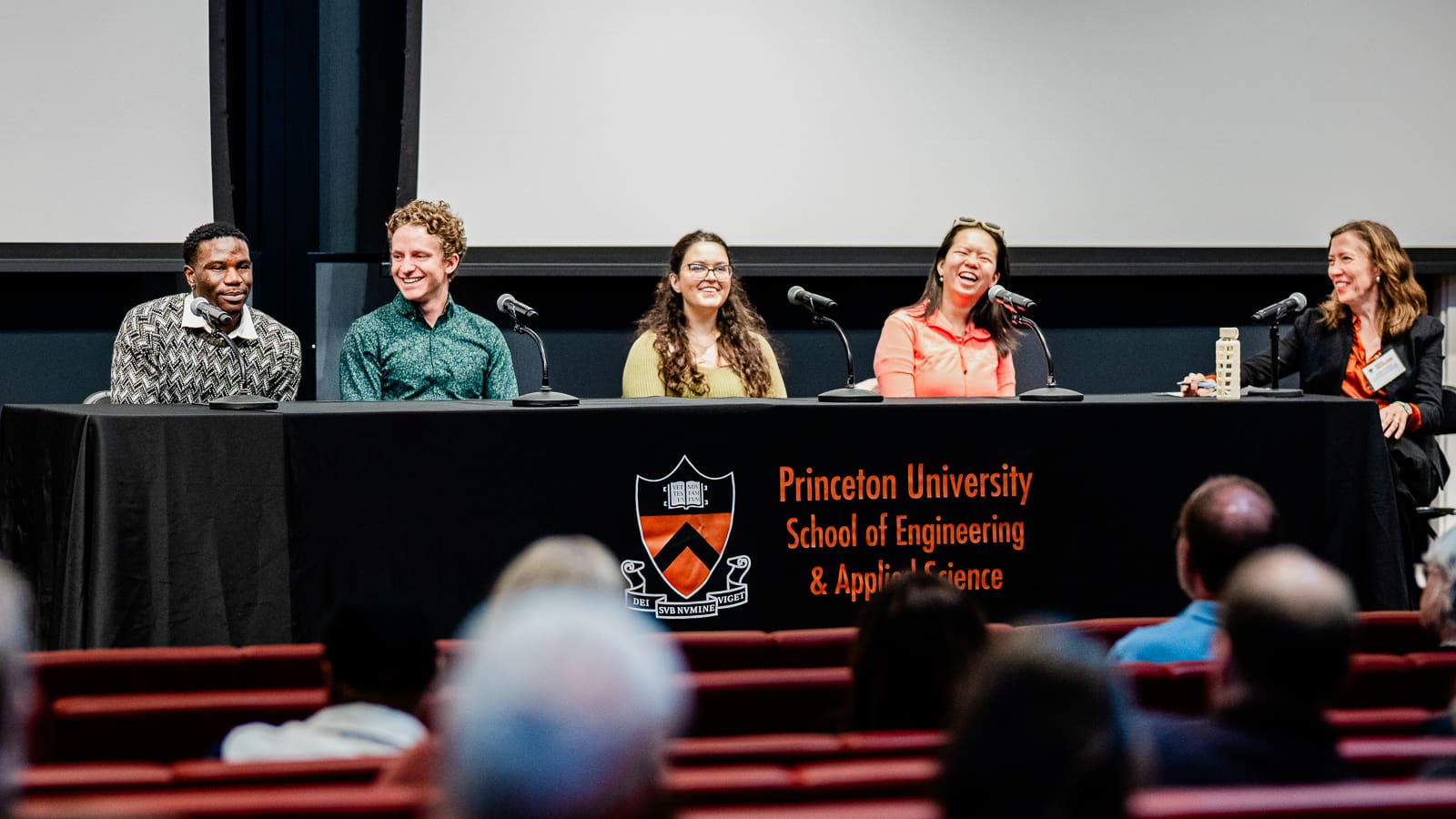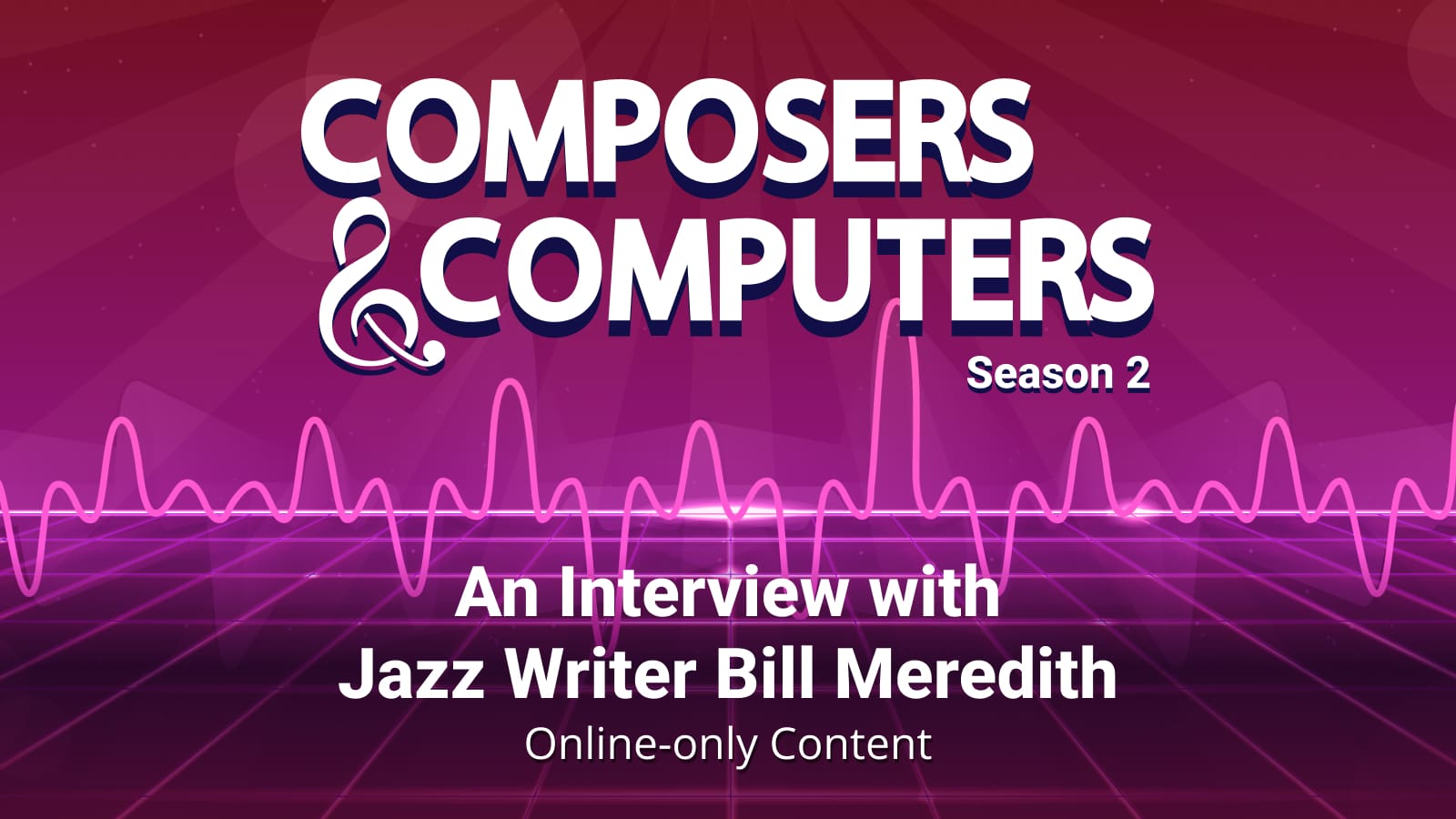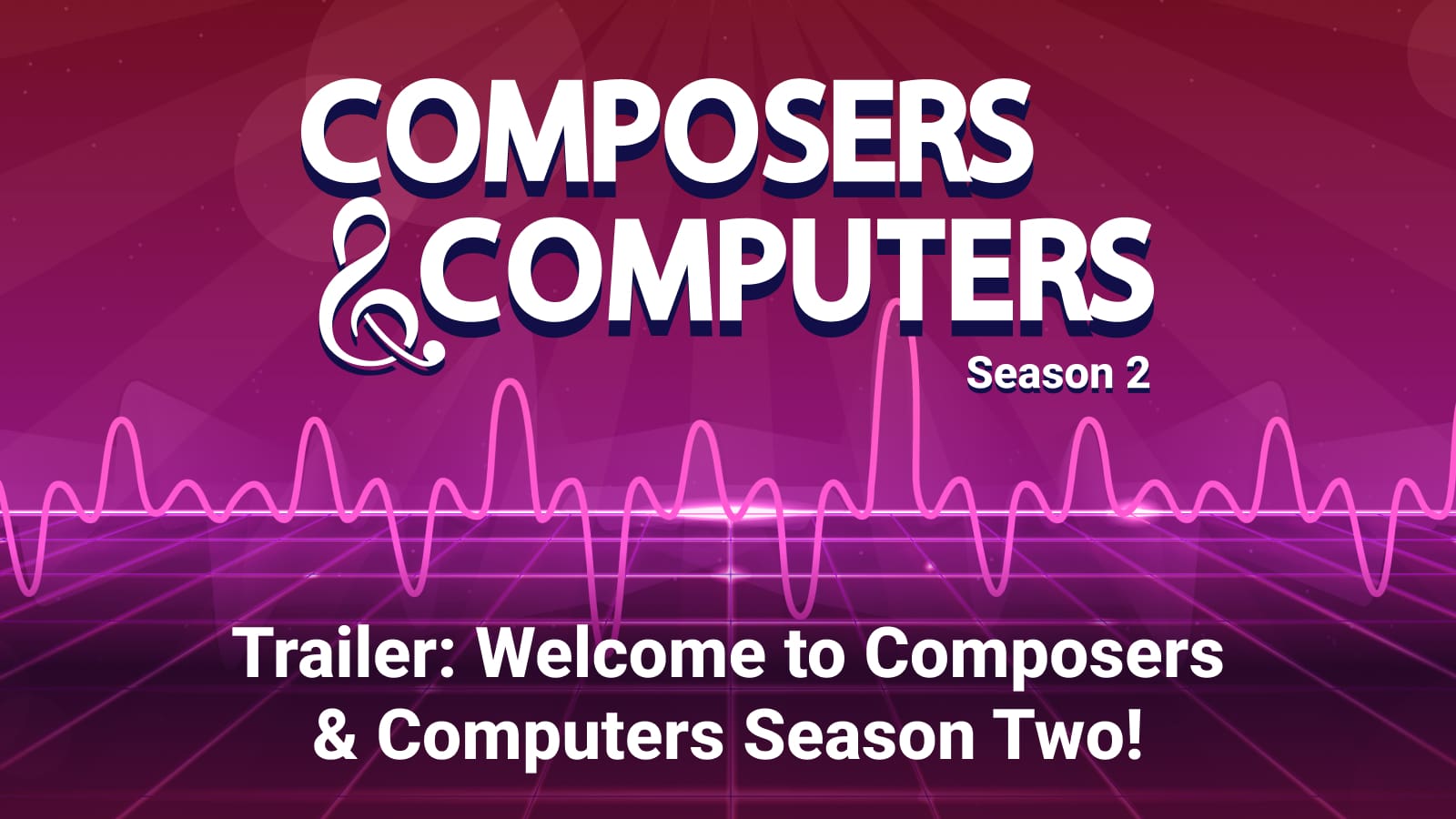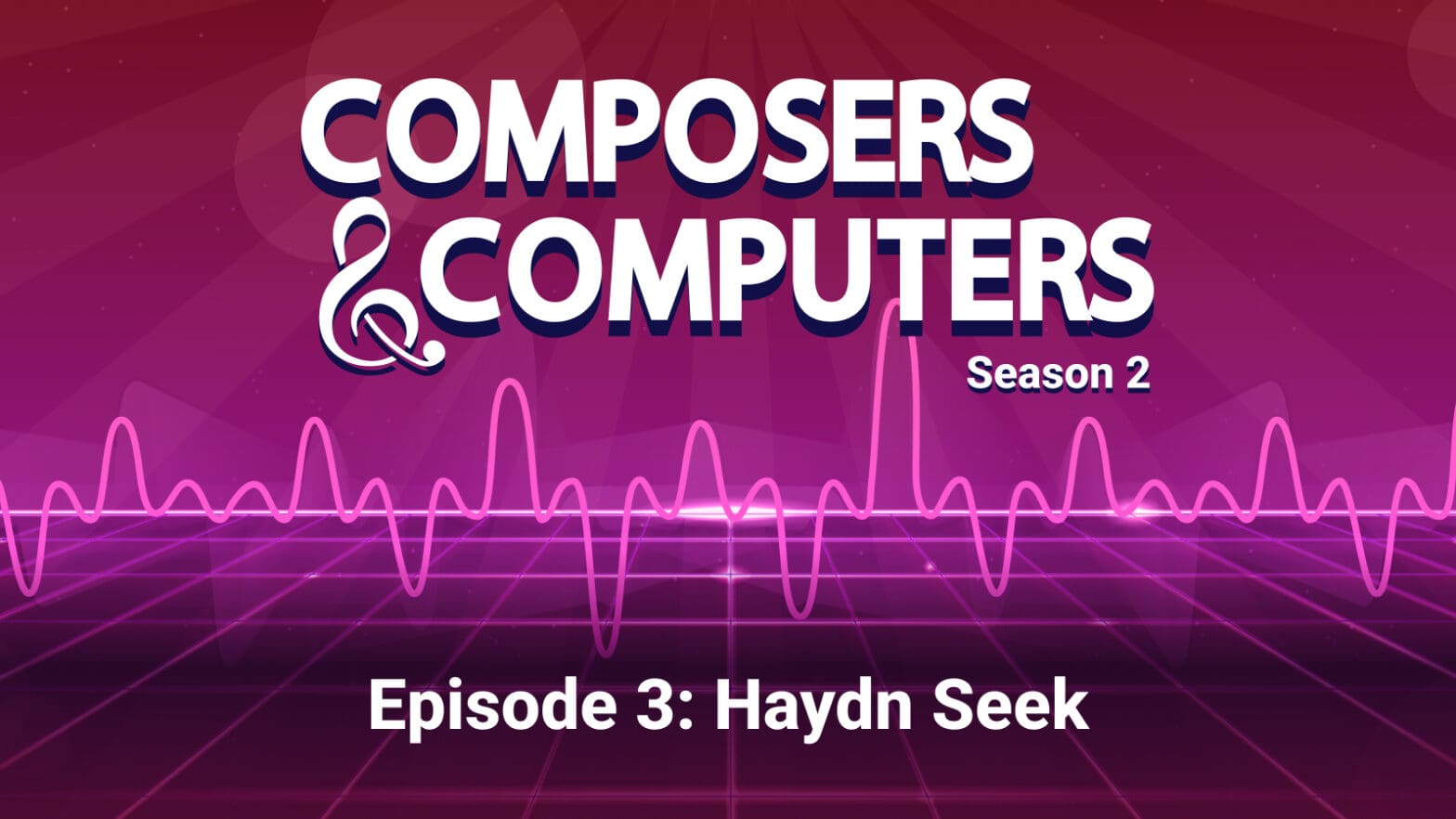
Episode 3: Haydn Seek
By
on
This is from the series Composers & Computers, a podcast
For all the remarkable work that Stanley Jordan did as an undergraduate at Princeton, he left no recordings of his computer music from that era. But he still had the memories, as well as some paper notes from an unfinished work.
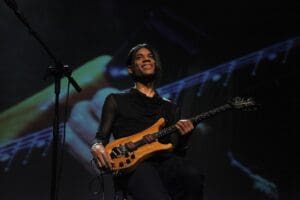
In this episode of “Composers & Computers,” Jordan does something remarkable: He recreates his lost composition, and premieres it here for the first time.
Part Pac-Man, part symphony orchestra, this three-minute piece is a testament to Jordan’s early musical journey through technical terrain, setting the stage for a career in which he has used technology to create dazzling ear candy.
“Haydn Seek was a composition I made in 1980 while I was studying computer music at Princeton,” Jordan wrote. “It was spawned from an assignment in a composition class with J.K. Randall, in which we were to take an existing piece of music and compose a new one using something that we liked in the original.”
Jordan based his composition on “Piano Sonata in A Major” by Franz Joseph Haydn. He was also studying computer music with Paul Lansky during this period, so he decided to make his composition for computer.
“This was an exciting time because computers were just beginning to be used as musical instruments. At that time computer music was only available at academic institutions and most of the music was very abstract. I loved that stuff, but I was more interested in bringing something new to traditional forms,” such as “Switched on Bach,” he said.
Jordan loved how Haydn got so much material out of a few simple patterns. In “Haydn Seek,” he takes Haydn’s original themes from the first movement, and expands on them in his own way, using more contemporary harmonies. At the beginning, everything is a condensation of Haydn’s main themes, taken exactly as Haydn composed them.
But then he starts blending in his own new material, growing and expanding until the piece is completely his own, but still related to Haydn’s original main theme.
The original version of Haydn Seek was incomplete and the materials were lost, so he recreated it here from memory, completing it using only compositional techniques and harmonic knowledge that he had at the time. In the video below you can see how he constructed it using Tone.js, emulating the core functionality of the program he would have used at the time, MUSIC360. The chart shows the notes plotted in a scatter plot based on a 6-line staff notation.
List of music played in this episode:
Mozart Symphony #39 in E flat K543 1. Addagio, Allegro. Performed by Roger Norrington: London Classical Players
Acte 3 – Scene 1 “Farfarello! Farfarello!” Richard Hickox: L’Amour des Troix Oranges
Haydn, Cello Concerto #2 in D, H 7b_2 – Allegro Moderato
Piano Sonata #22 in A Major Hob. XVI_2b_ 1. Allegro
Art Tatum, “Someone to Watch Over Me,” from the album “20th Century Genius”
Stanley Jordan, “Mozart’s Piano Concerto #21,” from the album “State of Nature.”
Quartet for Strings Lark Allegro Moderato by Haydn
Transcript
[00:00:01] Aaron Nathans: When we started this season, which focuses on Princeton music graduate and jazz legend Stanley Jordan, we noted that, sadly, none of the compositions that Jordan created on computer during his time here at Princeton survive today. But my call to Jordan clearly piqued his interest, and the wheels started turning. He still had some paper notes about his 1980 computer composition, “Haydn Seek.” Haydn, of course, refers playfully to Franz Josef Haydn, the classical composer who was born in 1732 and died in 1809.
[00:00:37] Aaron Nathans: One year and more than 50 hours of work later, amid a busy touring schedule and a very busy life, Jordan went ahead and completed a reconstituted version, just for us.
[00:00:48] Aaron Nathans: I was floored. And I’ll play it for you in just a moment.
From the School of Engineering and Applied Science at Princeton University, this is Composers & Computers, a podcast about the amazing things that can happen when artists and engineers collaborate. I’m Aaron Nathans.
[00:01:16] Aaron Nathans: Season Two, Episode Three: Haydn Seek.
So first, I’m going to play the piece, after which Jordan will tell us the story of how he created it. It’s a little under three minutes long. Remember, he made it using the equivalent of the technology that was available to him in 1980. So it’s going to sound charmingly retro. And so, at long last, here is the world premiere of Stanley Jordan’s completed version of “Haydn Seek.”
(Plays “Haydn Seek.”)
[00:04:40] Aaron Nathans: Well, here we are again with Stanley Jordan, a year later.
We’re so glad that you were able to rejoin us. And, wow, I can’t believe what just happened. Last time we talked, you were remembering a piece that you had created. We were talking about how there was no music left from your time at Princeton. It had all been lost, except maybe you had some notes written about one piece, and you had suggested that maybe you would recreate that piece for us. And I thought, okay, well, that would probably take a lot of time and effort. But then you went and did it, which is amazing, and I am blown away.
[00:05:23] Stanley Jordan: Thanks.
[00:05:24] Aaron Nathans: It’s. It’s creative. It’s cool. Back in the early eighties, I remember mom was playing a lot of classical music at home, and I was going to the arcade to hear Pac-Man. And it’s like I’m right back in that era all together now.
What was it about Haydn that… I mean, you took piano lessons as a kid, right?
[00:05:48] Stanley Jordan: I did, yeah. I mean, I must confess, I was a bit more of a Mozart fan.
Yeah, I did take piano lessons, and I was composing in kind of a sort of late romantic style. I realized that some of my favorite cartoons had some music from Prokofiev and so I followed up on that. It was from “The Love of Three Oranges.”
And so also, the sort of early modern Prokofiev style, too, really inspired me.
[00:06:39] Aaron Nathans: Like, Bugs Bunny tiptoeing?
[00:06:42] Stanley Jordan: Well, like, there was one cartoon called Johnny Quest. That’s the one I remember most, but there were others that had some stuff, like from the danger scenes where, you know, they were getting chased by some monster or something. They finally get away. And so there’s a whole sequence from one of the movements of “The Love of Three Oranges,” where you have the sense of the chase and the danger and all that, and then you come to safety. All that is in the music. And I remember one day, my mother was listening to the radio, and this piece came on, and I realized, oh, that’s the music I’ve been hearing in the cartoons. So that’s how I found out. That’s how I became a Prokofiev fan.
[00:07:23] Aaron Nathans: And how about Haydn?
[00:07:24] Stanley Jordan: But Haydn definitely. Yeah. So I’m sure I did play some stuff by Haydn in the early days of studying classical piano. I don’t have specific memories. I know for sure I did not play this piece that I used in “Haydn Seek.” But I think the reason that this came about, I think there were a couple of different courses. I was taking one course, my instructor, I guess, preceptor, I think, was Joe (inaudible), and we were doing something with Haydn. I think he was the one who brought this piece in and said, okay, I’d like to have you analyze this or something. We were exploring this in a class. Then I had another class I was taking from Jim Randall, and what Jim Randall would say is, take a composition that you like and then compose something else that has that same thing that you liked in the original composition. So it doesn’t have to sound like it necessarily. It’s just any aspect of it that you like, then go ahead and use that as a model for your own composition. And I love that approach. And so I decided to apply that approach to the piece by Haydn that I was studying in the other class, and so I just sort of started taking the original…
I kind of liked how, you know, it was fun. It was kind of cute because you had the “da da.” (musical cue)
You had that, and then you had a little wiggle. The “da da da da da.” But actually, the “da da da da da” is kind of an expansion of the “da da.” See what I mean? “Da da da da da da da.” And so this idea that you’ve got this really simple theme, about as simple as you can get. And then you expand on it. There’s one point where he’s got these triads marching down the scale, right?
And it’s kind of that scene, same thing, that step motion. And at a certain point, he goes, and he changes it into another key. He goes into minor and harmonic minor scale and all that. But still, this idea that it’s still based on these really simple motifs, I really loved that. So I just kind of imagined that, well, what if we just kept going and just kept sort of expanding? And I think another influence maybe was I was listening to a lot of Art Tatum at the time, and Art Tatum was a real interesting pianist because he was so brilliant and so creative. But the accepted format was to play popular songs. And so he would take the song, and then he plays a little bit of part of the melody. He’d make sure you hear the first, maybe just half of a phrase of the melody or maybe a whole phrase, and then he’d go in and he’d throw all his crazy stuff in there, and then he come back and he’d do the next normal part, and then he’d throw all his stuff in there. It just keeps expanding and expanding. You can start with the normal thing, and then you bring your own sound into it, your own ideas. That was sort of a model that I got from Art Tatum. So in a way, this piece kind of does that, you know, because I start out by condensing the main themes from that first movement, and I repeat that, and then the second time, when I repeat it, then I start to bring in some of my own ideas, and then it kind of expands more and more and more until the end is pretty much just my piece. Except, when you really dig into it, it has still kind of a seed from the original Haydn. So, like, for example, where you hear the sweeps at the end, the up and down sweeps, and then underneath that, there’s this sort of middle line was going, “dabba dabba dooba, dabba dabba dooba, dabaduba. Dabba dabba dooba, dabba dabba dooba.”
And so, see, that still comes from that. “Da da da da da.” You see, it still is based on that sort of the wiggle of Haydn’s original theme.
And I had a lot of fun with, with recreating this. It’s. I’m so glad you asked me to do it, because it was kind of a bummer that the original got lost, and it really was never fully completed anyway, in my mind, so this was an opportunity to go back and revisit that. And I remembered it a lot better than I expected to, and I remembered where I was going with it. And so I was able to complete it using just knowledge and techniques in composition that I knew at the time.
So, you know, if I were to do, to actually really do today’s version, I’m sure it would be different. But I tried to stick with what I was going for back in 1980.
[00:13:42] Aaron Nathans: What program did you use to create this?
[00:13:46] Stanley Jordan: So most of my stuff that I use for generating music electronically is my own software that I wrote in APL. And I originally learned APL at Princeton, and I’ve just been using it ever since. I mean, there was a brief period after I graduated, and you couldn’t get APL. You know, personal computers were just sort of starting out, and no one basically had one for a few years, and then you could finally start to get APL. So with the exception of that small gap, I’ve been using APL ever since. And so I know we’ve talked about that, but I just think it’s an awesome language. I did a demonstration last week for some geeks out in Silicon Valley, and I was thinking, you guys have to check out this language. It’s amazing. And they loved it. They were like, wow, we should be using this.
So I think that one thing that happened through the years is I think that the sort of conventional industrial software development world, it developed some conventions that weren’t so compatible with APL. I think APL is particularly suitable for people who are doing creative things where you don’t necessarily know the direction you’re going in complicated, one-shot problems where you have to solve a problem and then you get the solution and you move on. So that’s often the case in music. I think it’s a particularly good language in the creative fields, and so I think it could enjoy a renaissance when more people find out about it.
(intermission)
[00:15:29] Aaron Nathans: If you go to our show notes, you’ll see a special visual feature that Stanley Jordan has created, “Haydn Seek,’ plotted out on a computer screen in roughly the way it would have looked in 1981. The notes are plotted in a scatter plot format. You can see how he programmed it using the technology available to him at Princeton when he was a student here more than 40 years ago. You can find the show notes from a link at engineering princeton.edu. That’s engineering princeton.edu. It’s also available at the official Stanley Jordan YouTube page.
In our next episode. In the final episode of this season, we’ll go in an entirely different direction and interview Bethany Beardslee, musical collaborator of electronic music composer Milton Babbitt, and widow of computer music pioneer Godfrey Winham.
[00:16:18] Aaron Nathans: But for now, back to our interview with Stanley Jordan.
(end intermission)
[00:16:24] Stanley Jordan: The visuals that you see in the video for my recreation of “Haydn Seek,” that was my APL software, that grid, the chart that all the notes are plotted in. That was something that I originally did in APL when I was at Princeton, because what I started to do, we had two music synthesis languages. There was Music 4BF and Music 360, Music 4 written in Fortran, Music 360 written in assembler. The 360 version was less powerful, but it ran faster, and I really didn’t need all the power… Music 360 was fine for me. So I like the fact that I could get in there and use it quickly. So that’s the one that I mostly (used).
[00:17:13] Aaron Nathans: The sound itself, it sounds like Pac-Man. Is that just basically a sine wave?
[00:17:21] Stanley Jordan: No, it’s not just sine waves. I use a variety of waves. I use sawtooth waves, square waves, and I ran them into filters. It’s the same concept like from the Pac-Man days, like simple music synthesis. And I deliberately wanted to do that because those were the sounds that I had at the time. So the way that I realized it in this remake is I had to come up with something that would give me those old-school sounds. So what I did was I hooked my APL sequencer up to a library called Tone JS. So Tone JS is built on top of web audio API. And the cool thing about web audio API, it’s this JavaScript library that allows you to generate music on any device. So if you’re a programmer and you write your code to generate the music as you want it, you know that the people are going to hear the same thing no matter what platform they’re playing it back on. So although I love programming in APL, I love delivering in JavaScript for that reason. And it works great on the web, it works great on any device. So I went ahead and took the time to go back and emulate the core features of Music 360 that I used to use back in the day. I emulated it using Tone JS and I wired it into my APL stuff and I thought it would be easy. It definitely was a lot more involved than I expected. You know, I found some bugs and a lot of it unfortunately was spent troubleshooting, but I got it working. So I’m really excited about that.
[00:19:10] Aaron Nathans: How many hours did it take for you to create this?
[00:19:13] Stanley Jordan: You know, I was so busy, I wasn’t even charting the hours.
But I would say it’s got to be more than 50.
[00:19:22] Aaron Nathans: Oh, my God, for sure.
[00:19:23] Stanley Jordan: More than 50.
[00:19:24] Aaron Nathans: Wow.
[00:19:27] Stanley Jordan: Could be even close to 100, you know, over. Spread out over a period of time. It’s not like I worked on it every day, but when I would get back to it, you know, it was really a labor of love because I enjoyed the nostalgia of going back and revisiting a really sort of special time in my life and my development. And I think, you know, that’s one of the great things about music. I mean, as a student of music therapy, I love the fact that music can do that for people, for anyone, really. That music can give us a sort of a snapshot of a time in our life. And just going back and revisiting that music can really bring us back. And from a therapeutic point of view, many people gain a lot of resources that they had. So, for example, a person with Alzheimer’s could suddenly be, like, fully present and having a conversation. You know, it’s amazing that that power. So then, as a musician, it’s especially important for us because we can go back to music that we were working on.
And then that gives us another insight into it, too, because I can kind of see where I was at that time, and I remember what I was learning, and I see how far I’ve come, and I realized that, boy, I sure had a long way to go back then.
[00:20:51] Aaron Nathans: What memories do you think that it brought back for you? Were there snapshots? Were there scenes?
[00:20:58] Stanley Jordan: I loved the trek to the Computer Center. I know this may sound weird, but it’s like there’s something about, like, when something is hard to get, you know, like nowadays, you can just push a button and boom, the music comes out right in the system that we had. I could sit at my terminal in my dorm, and I could put in the APL code and I could generate my score, but I couldn’t hear it from there. I had to go to the Computer Center and get the digital tape and then go to the Engineering Quad and put it on a mini computer and spool it up. And only then could I hear the music.
And so just this idea that I’ve got this masterpiece in progress, and the next moment of this masterpiece is going to be revealed to me. I’m pretty sure it’s going to sound right. Maybe with just a little bit of tweaking. All I have to do is get to the Computer Center and it would be like midnight and it’s snowing, you know, and just… I mean, you know, I know it sounds like one of those legends, you know, ‘when I was your age,’ but really, I mean, it really was like that. And I was so excited. And then I go through the whole process, and I put it up and I’d hear it, and then I go, oh, okay, okay. Um. All right. All right.
Back to the dorm. I think I know what I need to do.
[00:22:26] Aaron Nathans: So have you ever released a classical piece before?
[00:22:30] Stanley Jordan: What I have done so far is I’ve taken classical pieces and I’ve approached them with a sort of a jazz approach.
So to give you an example, on my State of Nature album, I released the Andante from Mozart’s Piano Concerto, Number 21.
And the approach that I took to that is I imagined that it was like a standard, you know, just like a standard pop song or something. And so I worked out the chord changes in the melody, and I approached it like that. There’s a really cool book that a lot of people are using these days is called the Classical Fake Book. And they did a really good job of taking some of the more well-known pieces from the classical repertory and making lead sheets, you know, with chord charts. And the main theme. I didn’t completely agree. So I went in and I changed it as I heard it. And then I improvised on that because I’m going to expand on it anyway. But the point of it is that I wasn’t trying to play the piece originally as written.
It was definitely my version. But at the same time, I wanted to be true to the original, so I wouldn’t do something that didn’t fit the original. You know, I wouldn’t just slap my favorite bebop licks on top of some Mozart or something. But if Mozart gave me something that was like a, maybe just the seed of a blues lick, then okay, there, Mozart gave me that. I’m going to expand on that, and I’m going to do a whole blues phrase off of that. But it has to grow organically from the original.
[00:24:35] Aaron Nathans: Anything else that you’d like to talk about before we finish?
[00:24:40] Stanley Jordan: My mother attended a conference of computer music, and this was somewhere back in the late seventies, early eighties, and she heard pieces from different composers, and most of them came from various universities, because that’s where you could get a hold of that technology back then.
And she told me this funny story that there was kind of a running joke because this was after John Chowning had invented frequency modulation synthesis. So a lot of the people from Stanford were using FM, and they were getting these sort of sweeping timbres, you know.
And she said there was this sort of running joke at the conference where you had the Princeton beepers and the Stanford sweepers.
And I thought about that, and I said, well, I guess I’m one of the Princeton beepers, because a lot of my stuff was very angular and pointilistic, you know, so, yeah, okay. But then again, when I really thought about it, what would I do with all those grains of sound? Because that was sort of my specialty. It was granular synthesis. What would I do with all of that? Often I would take them and I would organize them into these sweeps. And so I guess I could sort of relate to both, you know? And again, it’s sort of like, once again, I find myself at the crossroads.
And in fact, at the end of “Haydn Seek,” where you have the sweeps going up and down, up and down, you have the sense of the sweeps, but actually those were created with individual notes.
[00:26:30] Aaron Nathans: Uh huh.
[00:26:31] Stanley Jordan: So in a way, it was actually both.
[00:26:33] Aaron Nathans: Was your mother also into computer music?
[00:26:36] Stanley Jordan: She wasn’t into computer music in particular, but she was into classical music. And not just traditional classical music, but what we call modern classical or modern serious music. As Milton pointed out, we always have difficulty with these terms. I remember him saying that on more than one occasion. But anyway, so I think that there was a book that she read when she was in college.
I believe it was by Aaron Copeland. I think it was the book what to listen for in music. It really helped her as a listener, and it helped her to appreciate not just traditional music, but stuff that was more modern, like Copeland, and even more contemporary than that, like the computer music stuff and the Milton Babbitt kind of stuff and all that. She was very open minded in terms of her ear and her ability to appreciate music. And so that was really helpful for me as a youngster because, you know, not that I was only doing it for my mom, of course, but the fact that I could explore music to my heart’s content and that I knew that my mom would appreciate it, that certainly was helpful.
It’s amazing the contribution that Haydn made. I mean, he was able to live so long, and that certainly was helpful, but just, he was just so prolific. I mean, wow, he did so much. And I know that he was one of Mozart’s teachers, and Mozart sort of took the Haydn sound and certainly expanded on that and did things that Haydn didn’t do. But Haydn was a bridge, in a sense.
You know, people classify him as a classical composer, but I think that he was a bridge between the baroque and the classical, you know, and his lifespan overlapped considerably with J.S. Bach, and yet his sound was different. And so, yes, you could find some sort of baroque or baroque influence elements of his music. He was one of the people who really started another sound. And then Mozart grew up within that and picked it up from there. It was just solid classical.
But I would say that Haydn was more influential in actually bringing in the classical period.
[00:29:37] Aaron Nathans: Well, I’m glad that he spoke to you and inspired you to create this incredible piece, and I’m really grateful for all the time you took to create the piece and to speak with us again today.
[00:29:51] Stanley Jordan: Well, thank you. And thanks for inspiring me to go back and do that. It was truly a labor of love.
[00:30:03] Aaron Nathans: This has been Composers & Computers, a production of the Princeton University School of Engineering and Applied Science. I’m Aaron Nathans, your host and producer of this podcast. Thanks to thanks to Mirabel Weinbach for the wave sounds. Thanks to the Princeton Music Department, including Renata Kapilevich, as well as the folks at the Mendel Music Library, for their support of this podcast.
[00:30:23] Aaron Nathans: Graphics are by Ashley Butera, Yoojin Cheong, and Neil Adelantar. Steve Schultz is the director of communications at Princeton Engineering. Additional thanks to Scott Lyon. This podcast is available on Apple Podcasts, Spotify, Google, Amazon, and other platforms. Show notes, including a listing of music heard on this episode, sources, and an audio recording of this podcast are available at our website, engineering. princeton.edu. If you get a chance, please leave a review. It helps. The views expressed on this podcast do not necessarily reflect those of Princeton University.
Our next episode should be in your feed soon. Peace.
